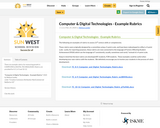
These are example rubrics for measuring growth in COMPUTER & DIGITAL TECHNOLOGIES. Rubrics are provided for K-5, 6-9 and 10-12.
- Subject:
- Education
- Material Type:
- Assessment
- Date Added:
- 02/24/2020

These are example rubrics for measuring growth in COMPUTER & DIGITAL TECHNOLOGIES. Rubrics are provided for K-5, 6-9 and 10-12.
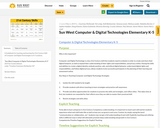
Sun West Computer & Digital Technologies K-5 Elementary Guidebook - please use the table of contents to navigate this guidebook. Also, we invite you to share resources you think would be suitable for this guidebook with any of the author's of this guidebook.
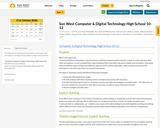
Sun West Computer & Digital Technologies High School 10-12 Guidebook - please use the table of contents to navigate this guidebook. Also, we invite you to share resources you think would be suitable for this guidebook with any of the author's of this guidebook.s.
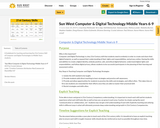
Sun West Computer & Digital Technologies Middle Years 6-9 Guidebook - please use the table of contents to navigate this guidebook. Also, we invite you to share resources you think would be suitable for this guidebook with any of the author's of this guidebook.
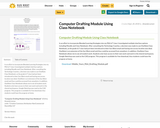
In an effort to incorporate Blended Learning Strategies into my PAA 6/7 class I investigated multiple interface options including Moodle and Class Notebook. After consulting the Technology Coaches, a decision was made to use OneNote Class Notebook, as the grade 6/7 class had just been introduced to their Sun West email and having one access location was ideal. OneNote is an extension of the Sun West email and thus could be accessed from anywhere. In addition, OneNote Class Notebook allows me to see all student work. Students only have access to their own work and work in the shared workspaces. Google Sketchup was used as the CAD program. This program is available for free download, thus students could have the program at home.
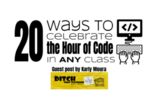
If you're not sure where to start to give your students a great experience during Computer Education Week in early December (or any time during the year!) this resource has a curated list of suggestions!
*grade level specific suggestions (K-2, 2+, 6+, unplugged)
*choice boards
*intro suggestions
*digital escape rooms
*a full unit
*robots
*more resources

The first video in Lesson 02: Computer Hardware. This video takes a quick look at the categories of computer hardware: processing, storage, input, and output.

Before keyboards, printers, even monitors there was processing. Processing is the reason computers are computers. Processing is the ability of the computer to take in raw data and basically make sense of it.
In this video we look at: Microprocessor (CPUs), Moore's Law, and Motherboard.

We examine storage devices in computers. This storage lecture has been broken up into to two section, this one focuses on hard drives and RAM, the next video covered removable storage devices.

The second part of our storage videos. This video looks at some of the removable storage media you can use. We look at floppy drives, CDs, DVDs, Blu-ray and ROM (flash memory).

Video 5 in our introduction to computers series looks at computer input devices. We examine some common input devices and look at how to clean your keyboard and mouse.

Our last video in our Computer Hardware lesson, part of the Introduction to Computers course.
This video looks at the most common output devices found on a computer we also list out top 5 resources, be sure to check them out.
http://arstechnica.com/
http://www.cnet.com/
http://www.newegg.com/
http://www.tigerdirect.com/
http://www.tomshardware.com/

Grades 3-5
"The Day of the Programmer is celebrated on the 256th day of the year. This is because programmers are familiar with bytes and 1 byte = 8 bits, which gives 256 (2 to the power of 8) different combinations of binary digits. In this lesson, students can celebrate programmers by creating art that showcases different programming languages! Students are provided a step-by-step tutorial, code blocks, and instructions to create a Computer Linguist project using Tynker. By the end of this lesson, students will have combined creativity and coding concepts such as simple motion, simple drawing, basic math, and input/output."
You can complete this task by using Tynker block coding - or click in the bottom right corner of the screen to use JavaScript.
This is a great activity to learn about programming languages.

Today we start a three episode arc on the rise of a global telecommunications network that changed the world forever. We’re going to begin with computer networks, and how they grew from small groups of connected computers on LAN networks to eventually larger worldwide networks like the ARPANET and even the Internet we know today. We'll also discuss how many technologies like Ethernet, MAC addresses, IP Addresses, packet switching, network switches, and TCP/IP were implemented to new problems as our computers became ever-increasingly connected. Next week we’ll talk about the Internet, and the week after the World Wide Web!

Students will recognize that computer science is so important because it can be found in almost every career. Don't wait, start learning how to code today.

The computer program's simulation of a Sonoran desert community should ultimately strengthen the student's comprehension of what is required for a natural ecosystem to sustain itself (remain in balance). This computer simulation program has great flexibility. It allows the student to manipulate the population numbers of five Sonoran Desert species. A species natural history attachment provides vital information for the students to familiarize themselves with each species' behaviors, its niche and food resource needs. The program includes two producers, the Saguaro cactus and the Ironwood Tree. It also includes 3 consumers, but their interactions both toward the producers and each other differ. The community's ability to remain in balance and sustain all five species so that none die out rests on the student's assessment skills enabling him to correctly identify these dependencies. The student learns by trial and error as he continues to fine tune the ecosystem that he maintains stewardship of.

The first video in the Computer Software series, part of our Introduction to Computers course. This video looks at the general types of software, software development, the software development life cycle, as well as explains what computer programers do.

Welcome to one of the most geeky videos in the entire series. This video will introduce you to the computer boot process, the way a computer starts from the moment you turn the computer on, till the operating system kicks in.

Video 3 of our Introduction to Computer course. This course looks at the basics of operating systems. We take a look at what an operating system is, file systems, user interfaces and command line.

In the previous video we looked at the basics of operating systems. In this video we take a look at the current operating systems available to consumer. In addition to looking at Windows, we also cover the current Mac OS X, Linux and Mobile Operating systems.
Links from video:
http://www.ubuntu.com/
http://knopper.net/knoppix/index-en.html